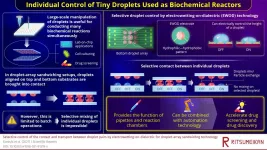(Press-News.org) DURHAM, N.C. -- You dash into a convenience store for a quick snack, spot an apple and reach for a candy bar instead. Poor self-control may not be the only factor behind your choice, new research suggests. That's because our brains process taste information first, before factoring in health information, according to new research from Duke University.
"We spend billions of dollars every year on diet products, yet most people fail when they attempt to diet," said study co-author Scott Huettel, a professor of psychology and neuroscience at Duke. "Taste seems to have an advantage that sets us up for failure."
"For many individuals, health information enters the decision process too late (relative to taste information) to drive choices toward the healthier option."
The new paper, which appears July 5 in Nature Human Behaviour, describes the advantage taste has over healthfulness in the decision-making process.
"We've always assumed people make unhealthy choices because that's their preference or because they aren't good at self-control," said study co-author Nicolette Sullivan. "It turns out it's not just a matter of self-control. Health is slower for your brain to estimate - it takes longer for you to include that information into the process of choosing between options."
The research was undertaken when Sullivan was a postdoctoral associate at Duke. She is now an assistant professor of marketing at the London School of Economics and Political Science.
For the study, Sullivan and Huettel recruited 79 young adults of a median age of 24.4 years. Study participants were asked to fast for four hours before the experiment to ensure they arrived hungry.
Participants were asked to rate snack foods on their tastiness, healthfulness and desirability. They were then presented with pairs of foods and asked to choose between them - and the researchers timed their choices.
At the end of the experiment, participants were offered one of the foods they had chosen.
Study participants registered taste information early in their decision process - taking about 400 milliseconds on average to incorporate taste information. Participants took twice as long to incorporate information about a snack's healthfulness into their decisions.
That may not sound like much time. In many cases though, it's enough to alter the choice we make.
"Not every decision is made quickly - house purchases, going to college - people take time to make those choices," Huettel said. "But many decisions we make in the world are fast - people reach for something in the grocery store or click on something online."
The authors say their findings could apply to other choices, not just food. For instance, some financial decisions, such as saving and spending choices, may also be affected by how -
and when - the brain processes different types of information.
Meanwhile, all is not lost in the war against junk food cravings.
Half of study participants received a blurb before the experiment, stressing the importance of eating healthy. Those participants were less likely to choose an unhealthy snack.
The authors also identified something simple that can help people with their food choices: slowing down the decision-making process.
When study participants took longer to consider their options, they tended to pick healthier ones.
"There may be ways to set up environments so people have an easier time making healthy choices," Huettel said. "You want to make it easy for people to think about the healthfulness of foods, which would help nudge people toward better decisions."
INFORMATION:
CITATION: "Healthful choices depend on the latency and rate of information accumulation," Nicolette J. Sullivan and Scott A. Huettel, July 5, 2021, Nature Human Behaviour.
DOI: 10.1038/s41562-021-01154-0
Injecting sulphur into the stratosphere to reduce solar radiation and stop the Greenland ice cap from melting. An interesting scenario, but not without risks. Climatologists from the University of Liège have looked into the matter and have tested one of the scenarios put forward using the MAR climate model developed at the University of Liège. The results are mixed and have been published in the journal The Cryosphere.
The Greenland ice sheet will lose mass at an accelerated rate throughout the 21st century, with a direct link between anthropogenic greenhouse gas emissions and the extent of Greenland's mass loss. To combat this phenomenon, and therefore global warming, it is essential to reduce ...
ITHACA, N.Y. - An interdisciplinary team of Cornell and Harvard University researchers developed a machine learning tool to parse quantum matter and make crucial distinctions in the data, an approach that will help scientists unravel the most confounding phenomena in the subatomic realm.
The Cornell-led project's paper, "Correlator Convolutional Neural Networks as an Interpretable Architecture for Image-like Quantum Matter Data," published June 23 in Nature Communications. The lead author is doctoral student Cole Miles.
The Cornell team was led by Eun-Ah Kim, professor of physics in the College of Arts and Sciences, who partnered with Kilian Weinberger, associate professor of computing and information science in the Cornell Ann S. ...
When you insist you're not racist, you may unwittingly be sending the opposite message.
That's the conclusion of a new study* by three Berkeley Haas researchers who conducted experiments with white participants claiming to hold egalitarian views. After asking them to write statements explaining why they weren't prejudiced against Black people, they found that other white people could nevertheless gauge the writers' underlying prejudice.
"Americans almost universally espouse egalitarianism and wish to see themselves as non-biased, yet racial prejudice persists," says Berkeley ...
A genetic map of an aggressive childhood brain tumour called medulloblastoma has helped researchers identify a new generation anti-cancer drug that can be repurposed as an effective treatment for the disease.
This international collaboration, led by researchers from The University of Queensland's (UQ) Diamantina Institute and WEHI in Melbourne, could give parents hope in the fight against the most common and fatal brain cancer in children.
UQ lead researcher Dr Laura Genovesi said the team had mapped the genetics of these aggressive brain tumours for five years to find new pathways that existing drugs could potentially target.
"These are drugs already approved for other diseases or cancers but have never been tested in paediatric brain tumours," Dr Genovesi ...
ST. LOUIS -- In the United States, low-income and minority students are completing college at low rates compared to higher-income and majority peers -- a detriment to reducing economic inequality. Double-dose algebra could be a solution, according to a new study published in roceedings of the National Academy of Sciences of the United States of America (PNAS).
The paper, "Effects of Double-Dose Algebra on College Persistence and Degree Attainment," is the culmination of a series of studies that followed two cohorts of ninth-grade students over a period of 12 years in the Chicago Public Schools (CPS) where double-dose algebra ...
Miniaturization is rapidly reshaping the field of biochemistry, with emerging technologies such as microfluidics and "lab-on-a-chip" devices taking the world by storm. Chemical reactions that were normally conducted in flasks and tubes can now be carried out within tiny water droplets not larger than a few millionths of a liter. Particularly, in droplet-array sandwiching techniques, such tiny droplets are orderly laid out on two parallel flat surfaces opposite to each other. By bringing the top surface close enough to the bottom one, each top droplet makes contact with the opposite bottom droplet, exchanging chemicals and transferring particles or even cells. In quite a literal way, these droplets can act as small reaction ...
BUFFALO, N.Y -- Children who eat slower are less likely to be extroverted and impulsive, according to a new study co-led by the University at Buffalo and Children's Hospital of Philadelphia.
The research, which sought to uncover the relationship between temperament and eating behaviors in early childhood, also found that kids who were highly responsive to external food cues (the urge to eat when food is seen, smelled or tasted) were more likely to experience frustration and discomfort and have difficulties self-soothing.
These findings are critical because faster eating and greater responsiveness to food cues have been linked to obesity risk in children, ...
A new study examining why young South Asian heart attack patients have more adverse outcomes found this patient population was often obese, used tobacco products, and had a family history of heart disease or risk factors that could have been prevented, monitored for or treated before heart attacks happen. The study will be presented at the ACC Asia 2021 Together with SCS 32nd Annual Scientific Meeting Virtual being held July 9-11, 2021.
"South Asians tend to have multiple co-morbidities including diabetes and obesity at younger ages which is different from the white population," said Salik ur Rehman Iqbal, ...
Research conducted at Cruzeiro do Sul University in São Paulo, Brazil, can contribute to earlier diagnosis of diabetic neuropathy, a disorder characterized by damage to peripheral nerves, with symptoms such as pain and paresthesia (pricking, burning and numbness), mainly in the legs and feet.
In the study, a group led by Professor Paulo Barbosa de Freitas Júnior measured grip force in diabetic patients while they were holding and handling objects. The results were compared with data for healthy subjects and patients with other neurological diseases, such as multiple sclerosis, Parkinson’s, and carpal tunnel syndrome (pain, numbness and tingling in the hand and arm caused by a pinched nerve in the wrist).
Freitas and his ...
July 7, 2021 - The murders of George Floyd and other Black Americans have prompted a national outcry against structural racism and police brutality. How are leading nursing organizations and schools of nursing defining their positions on racism? That's the topic of a special article in the July/August issue of The Journal of the Association of Nurses in AIDS Care (JANAC). The official journal of the Association of Nurses in AIDS Care, JANAC is published in the Lippincott portfolio by Wolters Kluwer.
Three major national nursing organizations and many top-ranked schools ...



